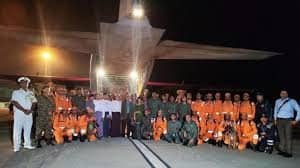
India’s Operation Brahma has indeed garnered significant attention and praise for its swift and comprehensive response to the devastating 7.7-magnitude earthquake that struck Myanmar on March 28, 2025. Launched as a humanitarian mission, it reflects India’s commitment to being a “first responder” in times of crisis, particularly in its neighborhood, under the philosophy of “Vasudhaiva Kutumbakam” (the world is one family). Here’s an overview based on available information:
India mobilized an impressive array of resources under Operation Brahma, delivering over 625 metric tonnes of humanitarian aid and disaster relief (HADR) materials to Myanmar by April 1, 2025. This effort involved six aircraft and five naval ships, including INS Gharial, INS Satpura, and INS Savitri, carrying essentials like food, medicine, tents, and rescue equipment. The Indian Army established a 200-bed field hospital in Mandalay, operational within days, treating over 104 patients, including performing two major surgeries by April 1. The National Disaster Response Force (NDRF) deployed 80 personnel, conducting search and rescue operations at multiple sites, such as the U Hla Thein monastery, where around 170 monks were trapped, and Ganga Ghat Mandir.
Myanmar locals and media have expressed gratitude for India’s efforts. Reports highlight sentiments like “May God shower blessings upon India and its leadership,” reflecting appreciation for the timely aid following the earthquake that claimed over 2,719 lives and left thousands injured or missing. This response has been framed as a standout effort, especially as India stepped up where others were perceived to lag.
Comparatively, China’s response, while notable, included a $14 million aid package, 118 rescuers, six rescue dogs, and supplies like 1,200 tents and 8,000 blankets, with teams arriving by March 30. They rescued six people, including a child and a pregnant woman, showcasing their capability. However, India’s broader deployment—spanning air, sea, and ground operations—appears to have cast a wider net, both in scale and visibility. The West, particularly the U.S., has been criticized for a muted response, attributed to foreign aid cuts under President Trump, with no significant U.S. team reported on the ground by April 1, leaving a gap that India and China filled.
Myanmar’s media and public sentiment, as reflected in early reports, seem to spotlight India’s rapid, large-scale intervention as a benchmark, with Operation Brahma emerging as a symbol of solidarity. While China’s efforts were effective and the West’s were limited, India’s multi-faceted mission—combining rescue, medical support, and substantial aid—has been portrayed as outshining others in scope and impact, earning it praise as a compassionate leader in the region.





